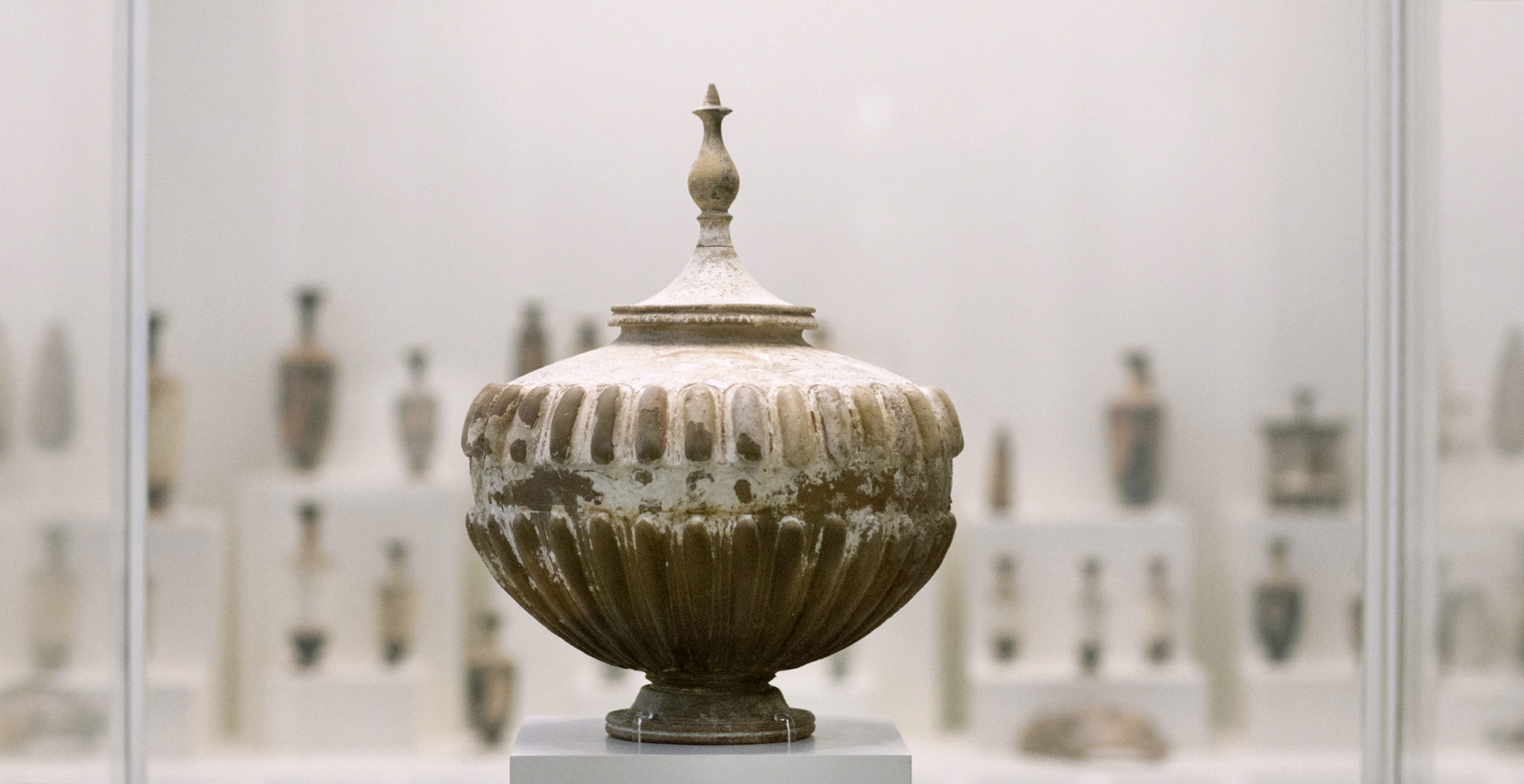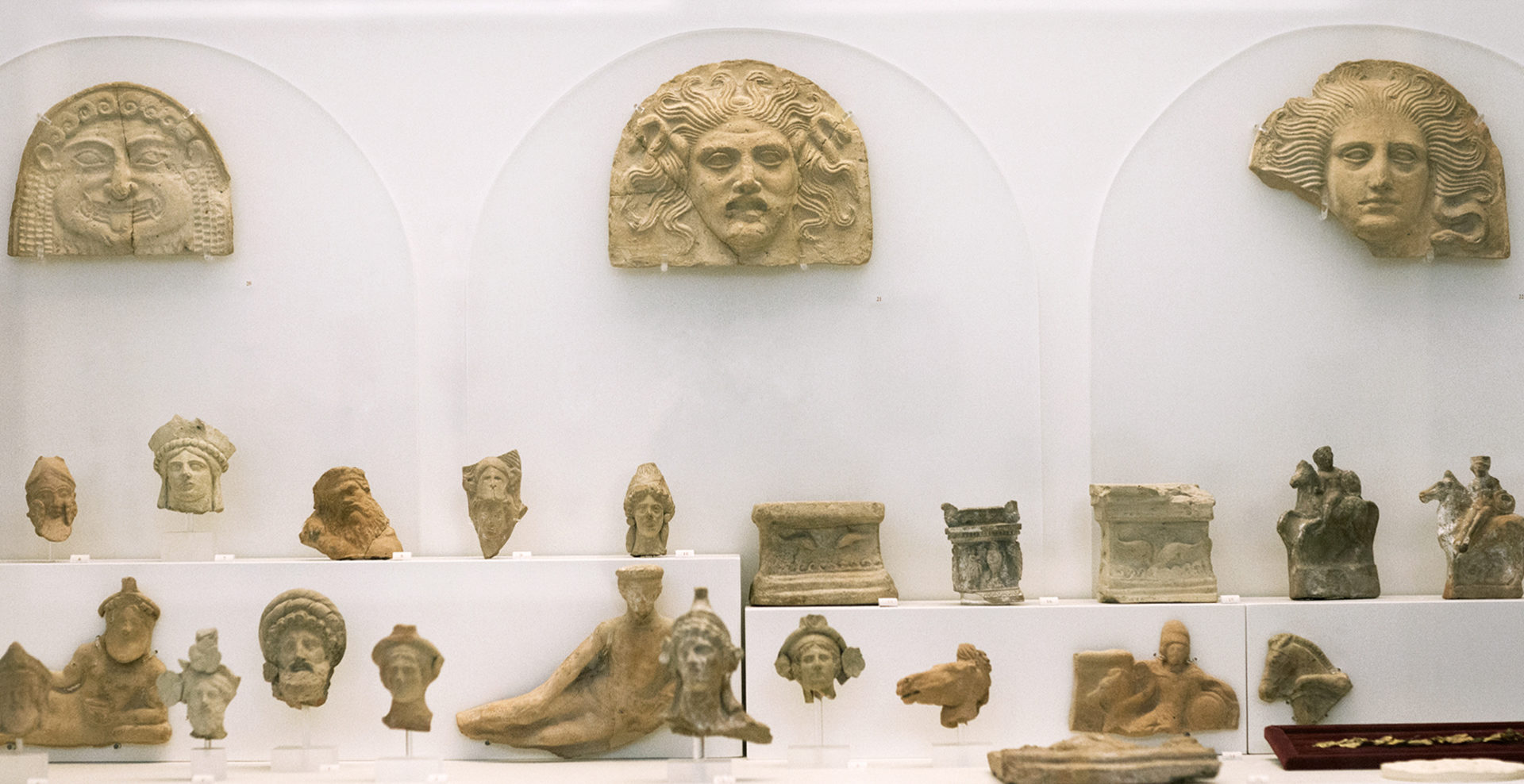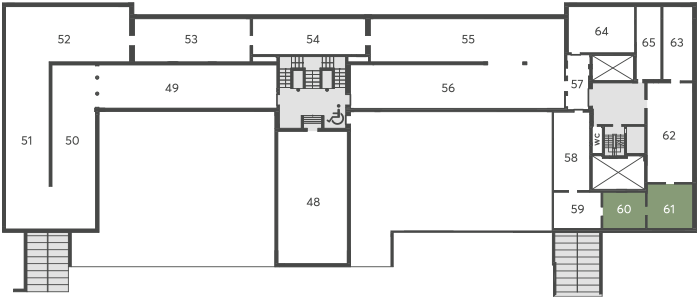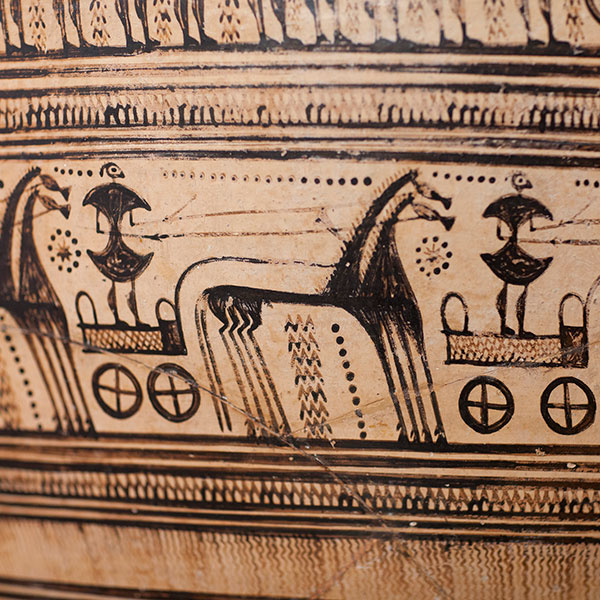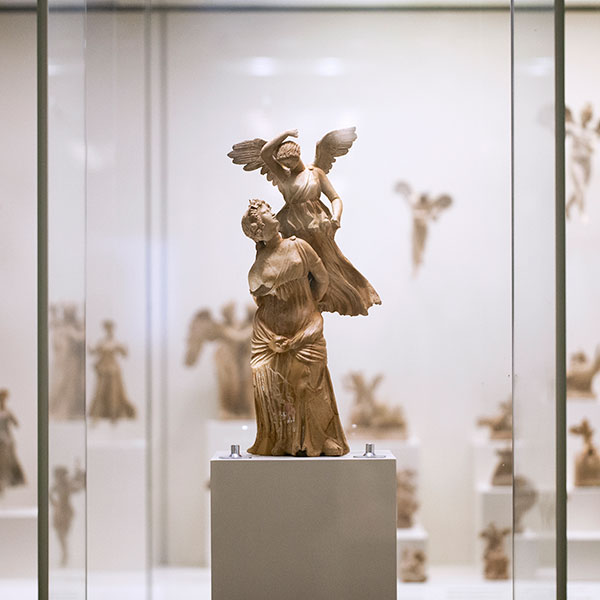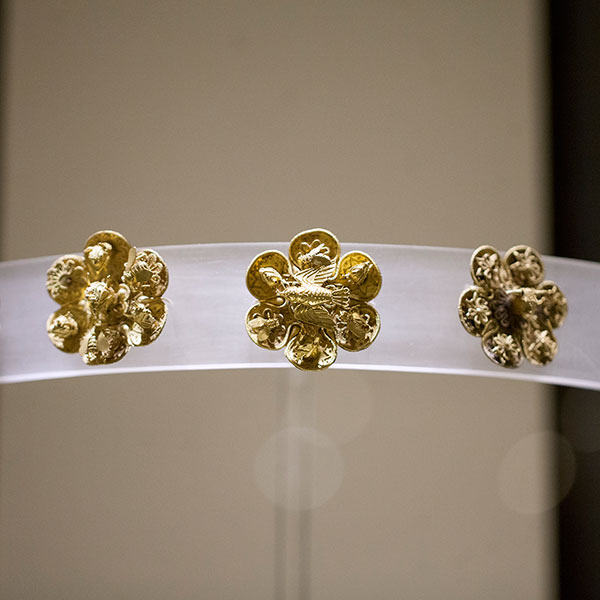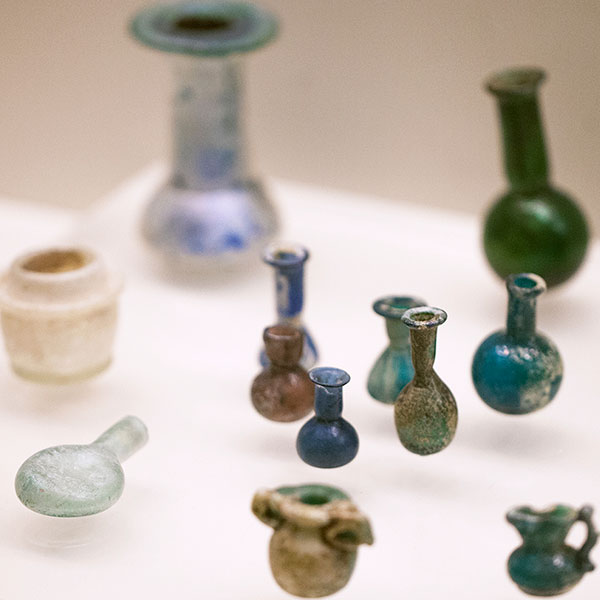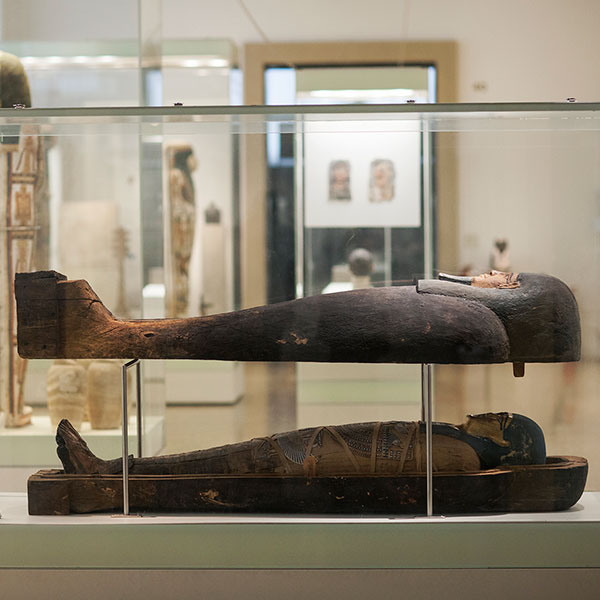Vlastos-Serpieris Collection
Michael P. Vlastos belonged to the Greek Diaspora. He was born in Athens in 1874, but spent most of his life in the United States, Great Britain and mainly Marseille.
The noble military Vlastos family is of byzantine descent from Constantinople and Chios. Tradition has it that a member of the Vlastos family was among the twelve noble youths whom the byzantine emperor Alexios II Komnenos Porphyrogenitos (1180-1183) sent to Crete together with their families in order to prepare the defence of the island against the Arabs and the pirate raids. Following the conquest of the island by the Ottomans in 1669, branches of the family were dispersed across the entire Mediterranean. Those descendants of the Vlastos family who remained on Crete played a leading role in the successive liberation movements of the island. Other members of the family emigrated to Chios which they abandoned after the devastation of the island by the Ottomans in 1822, moving to Dalmatia, Spain, Italy and Marseille where the surname Vlastos is still preserved even nowadays.
In Marseille, where there was a prosperous Greek community, Michael Vlastos undertook the management of the branch of a major trading house of the Rallis Brothers that was based in London and operated branches in the greatest financial centres of the time. Distinguished Greeks of Marseille with whom Vlastos maintained close relationship, were deeply involved in the establishment of the Association of Friends of the National Archaeological Museum. In 1900 he married in Marseille Regina Lidoriki. Together they had two children, Pantelis and Penelope-Ioulia, who later married Ioannis Serpieris. It should be noted that Vlastos was not a magnate of immense financial strength, like other collectors of his time. He was rather a well-off bourgeois who had received broad education and was infused with the collector’s instinct that became manifest in his deals with the antiquities merchants at Pandrosou Street in Athens. Even though he was self-taught, his archaeological education was deeply ingrained. At that time, the code of ethics that governed the collection of antiquities was quite different from today. The means by which antiquities were acquired and the collaboration with merchants of antiquities, even smugglers, were not reprehensible by the whole scientific community, since even highly acclaimed archaeologists possessed small archaeological collections.
In 1988 apart from the collection, the National Archaeological Museum also received the archive of the collector packed in six large boxes that contained notebooks as well as loose leaves with handwritten notes and drawings by Vlastos and also photographs of objects of his collection and the interior of his house. The archive included material from the time at which the Association of Friends of the National Archaeological Museum was founded, such as legal documents, contribution lists, editions and press clippings associated with the early activities of the Association and also the rich correspondence of the collector with eminent figures of archaeology in the 20th century, such as Sir John Beazley, with whom Vlastos was close friend and collaborator, Paul Jacobsthal, Humphry Payne, Gisela Richter, Ernst Buschor, Sir Arthur Evans and many others. A large part of the archive consists of documents pertaining to the future of the collection, from Vlastos’ death on the 4th of September, 1936 to its admission to the National Museum. In the archive an exact copy of Vlastos’ will is preserved, accompanied by relevant documents and also printed material of the time that reflects the esteem which Vlastos enjoyed among the archaeological community and the sorrow which his death brought about.
The first systematic archaeological research of Vlastos was based in Marseille, where he lived, and Tarentum, the significant Spartan colony in Magna Graecia. Within a few years Vlastos had created a vast collection of approximately 10.000 coins from Tarentum, exquisite indeed in terms of the diversity and the quality of its coinage. Concurrently, he donated coins, already since 1900, to the Numismatic Museum of Athens. However, he was not circumscribed to the collection of coins merely. He maintained contacts with eminent numismatists of his time, such as Oscar Ravel who published the catalogue of his numismatic collection in 1947. What differentiated Vlastos from his contemporary collectors was that he performed methodical classification of his collection himself and published numerous studies on numismatics. Even today his body of work on Tarentine coins is considered essential. Vlastos’ prestige was so highly acknowledged that he was invited by the Italian authorities to classify the numismatic collection of the Museum of Taranto.
At the end of 1932 he decided to move to Athens. He left his numismatic collection to his son Pantelis who had stayed at Marseille. After Vlastos’ death, this unique collection was sold in 1947 and, through auctions, ended in numerous private collections and museums.
In Marseille Vlastos was not limited to the collection of coins exclusively. He formed there the initial core of his collection of antiquities, by purchasing at auctions and from other private collections objects that came from Italy, mainly Tarentum, but also antiquities that reached him from Greece.
When he finally settled in Athens in 1933, Vlastos brought with him all of the Greek and Tarentine antiquities he was in possession of and turned immediately to the domestic market. His antiquities were rapidly multiplied and as a result his collection amounted at the time of his death to approximately 760 artefacts. The collection was housed in Vlastos’ residence at 3, Lykeiou and Stisichorou Street.
The Vlastos archive includes the notebook in which the collector systematically recorded in chronological order his acquisitions before he even settled in Greece. The significance of the information provided by that notebook is paramount. For instance, we are now informed that the fragments of the funerary plaque of Lydos from Spata (see display case 8) were purchased on the 11th of September 1934 from the antiquities merchant Theodoros Giannopoulos for 4.483 drachmas. On the 17th of November 1933 he purchased, from the same merchant, the fragments of the Sophilos funerary plaques for 2.900 drachmas. The archive also contains some receipts from known antique shops at Pandrosou Street.
The most significant archaeological contribution of Vlastos is another notebook of his in which his scientific profundity is attested and also his drawing aptitude, almost artistic as one could argue, is revealed. These virtues are manifested in his published numismatic studies also. However, in this case we are dealing with the combination of both, applied to original and unknown material. This notebook constitutes draft of an uncompleted volume of the Corpus Vasorum Antiquorum of his collection. As evidenced by the note on the first page, its writing began in Marseille on the 25th of May 1931. The volume which Vlastos himself prepared, assisted by Sir J. Beazley who collaborated closely with him, includes 130 vases of the collection. He commented them, cited exhaustive bibliography, added photographs and, most importantly, produced their drawings himself. Vlastos’ drawings, rendered in watercolour, are not only highly accurate, but also of exquisite artistic value, and undoubtedly betray the passion and care which he showed for the objects of his collection. The usefulness of this nearly complete Corpus is of major importance, because Vlastos published all available archaeological data for each artefact, namely its provenance, other related finds retrieved concurrently, time of purchase and name of the antiquities merchant.
In parallel with his collecting and research activities, Vlastos played a leading role in the foundation of the Association of Friends of the National Archaeological Museum, following the example of the great Museums worldwide, mainly the Louvre. For this purpose he recruited many Athenian antiquarians as well as Greeks of Marseille. Vlastos was elected the first president of the Association, from its establishment in 1934 to his death in 1936. Among others, the metal template of the stamp of the Association of Friends was found, designed and signed on the 5th of March 1934 by Émile Gilliéron, son, a renowned artist of the National Archaeological Museum (display case 9). Early on, the Association of Friends became highly active. Until Vlastos’ death it purchased and donated to the Museum a large number of antiquities, such as the oinochoe no XXXX. In addition, it published its undertakings in a special bulletin and the Athenian press. One of the most important donations was the particularly significant black-figure funerary vases of Vari, which is identified with the ancient deme of Anagyrous (Room 50, display cases 35-38). At the beginning of 1935, as soon as the Association of Friends was notified about the smuggling that was taking place in the area and the presence of artefacts of the burial ensemble in the antiquities market, he promptly proceeded with its acquisition on behalf of the National Archaeological Museum, following the advice of the highly acclaimed archaeologist and director of the British Archaeological School at Athens, Humphry Payne, with whom Vlastos maintained a friendly relationship.
Vlastos was actively involved in the affairs of the Archaeological Society. Shortly after his return to Athens he was unanimously elected on the 7th of June 1933 ordinary Partner of the Archaeological Society and on the 22nd of December of that year he became member of its Board.
The death of Michael Vlastos on the 4th of September 1936 plunged the whole archaeological community into grief. Articles published in the Greek and international press praised his personality and contribution. Letters of sympathy and condolences were being sent to the Vlastos family for months after his death, signed by eminent archaeologists.
The archive contains a copy of his will in which, among others, he made his wish explicit to donate his archaeological collection to the National Archaeological Museum. Following the death of Michael Vlastos and his wife Regina the famous collection that comprised 776 works was bequeathed to his daughter Penelope-Ioulia, wife of Ioannis Serpieris. Throughout the period in which Penelope-Ioulia was in possession of the collection, from the death of her mother until 1985, a time in which she passed away, the care which she showed for its maintenance and proper management for the benefit of the scientific community were indeed remarkable. We are informed from the archive that during World War II the collection was stored in the basements of her residence. Later, when the house was commandeered by the German conquerors, the collection was delivered to the International Red Cross for storage.
The collection was known in the authorities and accessible to the international archaeological community. Varvara Filippaki, Ephor of the Vase Collection of the National Archaeological Museum, responsible for the scientific publication of the collection, was the first to fully document and arrange the antiquities in showcases. The contribution of V. Filippaki, who maintained personal relations with Penelope-Ioulia Serpieri, was decisive for the ensuing delivery of the Collection to the National Archaeological Museum.
During the period in which Vlastos’ daughter owned the collection she frequently received requests by various archaeologists of the time, Greek and foreign, who asked permission to study artefacts of her collection. The study of the correspondence exchanged between the Vlastos family and the scientific community enable us to experience again the stages in the preparation of significant archaeological discourses.
After the death of Penelope-Ioulia Serpieri, her husband, Ioannis Serpieris, legitimate inheritor of the Collection, and their children (Patricia-Lauria Papadimitriou, Savina I. Serpieri and Fernandos I. Serpieris) took all necessary steps in order to donate the collection to the National Archaeological Museum in accordance with the will of M. Vlastos.
In April 1988 the Collection was eventually donated to the National Archaeological Museum where it was transferred in May of that year by Eo Zervoudaki, then Ephor of the Vase and Minor Arts Collection.


